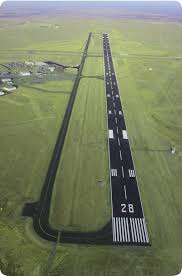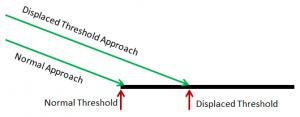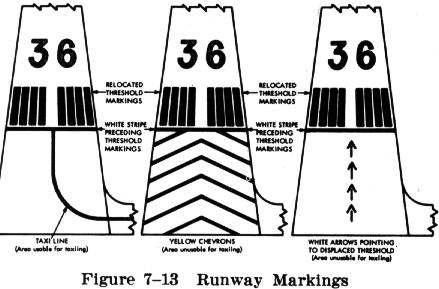You may have heard the term before: “Displaced Threshold;” but you may not know what it actually means. Your airport may not have one, so you probably have never seen what one looks like, or even given it all that much thought.
But a displaced threshold is a common thing to see at an airport, and there are at least a couple of good reasons that your airport might have a displaced threshold or two (or more!).
First – what does a displaced threshold look like? How do you know when you are seeing a displaced threshold?
Let’s start by talking about what a “threshold” is – on airport runways, the threshold is the beginning of the runway. It’s as simple as that.
Or is it?
The runway threshold is marked with white lines parallel to the length of the runway (see image below):
 See at the bottom of the image, the two sets of long skinny white lines, just below the runway number?
See at the bottom of the image, the two sets of long skinny white lines, just below the runway number?
Those are your “Threshold Markings” – telling you where the runway begins. Notice that, in this case, there is no white line perpendicular to the runway length just before the threshold markings, because the pavement just starts right there.
You can’t see it in the picture, but the runway threshold will also have green lights to show a pilot approaching to land where the runway begins at night. If you approached the end of the runway from the other side, you would see red lights instead of green, signifying the runway ending (see image below).

See? Green on one side, red on the other! Neat, huh?
Anyway, a “displaced” threshold is a way to start the actual runway somewhere beyond where the pavement starts.
Why would they do that? Don’t you generally want as much pavement as possible to land on or takeoff from?
There are at least a couple of reasons why a runway threshold would be displaced:
- increases obstacle clearance
- reduces the noise footprint below any approaching aircraft
How does a displaced threshold do this? By elevating the glideslope over any given point along the landing approach.
Whaaaaaa…?
Think about it – actually don’t. Let me draw you a picture.

See how the displaced threshold approach is higher at any given point than the normal approach? So the noise from an approaching aircraft will be less to anyone on the ground because the plane is farther away (higher) – making noise abatement a valid reason for a displaced threshold. It also means that if there were some sort of building or tower in line with the runway, that a landing aircraft could avoid it by flying over it – also a valid reason for a displaced threshold.
So what does a displaced threshold look like? Pretty much the same as a regular threshold, only there will be a white line perpendicular to the length of the runway, AND there will be an indication about what (if anything) the unused pavement CAN be used for:
 On the left, you’ll see the taxiway line extending right up to the displaced runway threshold. In this case, you cannot use the pavement for anything but taxi (or overrun, if landing from the other direction).
On the left, you’ll see the taxiway line extending right up to the displaced runway threshold. In this case, you cannot use the pavement for anything but taxi (or overrun, if landing from the other direction).
In the center, you’ll see chevrons (they will be yellow in the real world) – meaning this area cannot be used for taxi or for takeoff run (but again, could be used for overrun if landing from the other direction). Usually you will see the taxiway enter the runway at or after the displaced threshold in this case.
And on the right, you see arrows (white in real life), meaning the area cannot be used for landing, but should be used for the takeoff run. The common denominator between any of them is that you MUST land at or beyond the threshold, not prior to it in any case. The meanings are mainly important for taking off from this direction – then it’s important to know what the markings mean.
Do you know of any other reasons a displaced threshold might exist? Do you have displaced thresholds at your airport? Land your knowledge in the comments below!
Andrew Hartley is a Certificated Flight Instructor in Columbus, Ohio.